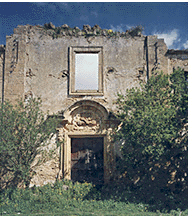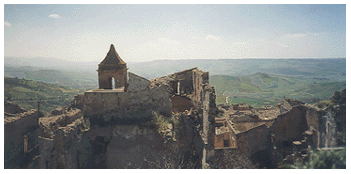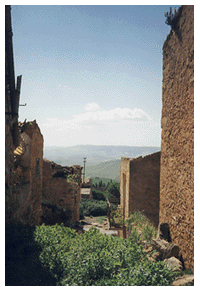...Best of Sicily
presents... Best of Sicily Magazine. ... Dedicated to Sicilian art, culture, history, people, places and all things Sicilian. |
by Carlo Trabia | ||||
Magazine Best of Sicily Arts & Culture Fashion Food & Wine History & Culture About Us Travel Faqs Contact Map of Sicily |
No voices. No old men talking. No children playing. No cars parked along
the narrow streets. And none of the swooping swallows typical of inhabited
towns of the Sicilian interior. The landmarks of Poggioreale can still be
seen. There's the gutted church whose Neo Classical facade seems untouched
by disaster, and another church whose bell tower stands defiantly. A solitary
survivor. One wonders why fate, or perhaps a Higher Authority, saw fit to
all but destroy one church and spare the other. While Poggioreale is not
what one would consider a tourist Sicily is full of ruined castles and the remains of ancient cities, but Old Poggioreale seems more surreal than historical. Here one feels a closer kinship with the people who lived here (many of whom now reside in "New" Poggioreale). They're not ancient Greeks or medieval Normans. They're more like us. Perhaps that explains why Poggioreale's ironic beauty is mildly disturbing. And the ghosts? If they could speak to us, what would they say? In the case of this ghost town, the ghosts are few, since most of Poggioreale's residents escaped to survive the natural disaster. A very few who refused to abandon their homes perished. In a place like this, one instinctively seeks a message, but there is none. There are only impressions.
About the Author: Catanian architect Carlo Trabia has written about medieval architecture for various magazines and professional journals. (This article was translated from Italian.) | |||
Top of Page |
 It seems like something out of the American Old West --without the tumbleweed.
Poggioreale, like several other towns in Sicily's Belice Valley, was extensively
damaged by an earthquake in 1968. Consequently, the old town was abandoned
and a new one established a few kilometres away. Unlike nearby Salaparuta
(also abandoned), which has a castle, Poggioreale was not a medieval town;
it was founded in the eighteenth century, making it new by Sicilian standards.
The earthquake claimed few victims at Poggioreale, whose name means "royal
well." It did, however, destroy much of the village, leaving the impression
of a town demolished by poorly targeted bombs. It was precisely for this
reason that Sicilian director Giuseppe Tornatore used it as one of the locations
of his 1995 movie The Star Maker, which takes place in Sicily in
the aftermath of the Second World War. In Summer, when the surrounding countryside
is amber and brown, Poggioreale, even viewed from a distance, assumes the
look of a ghost town in a Spaghetti Western --with no cowboys in sight.
At night, with bats flying around, it seems haunted. But the sunlight of
a Spring morning makes the deserted Sicilian town, its stone and brick streets
overgrown with wildflowers and weeds, look as though it were part of a divine
medieval experiment. Or perhaps an ancient one.
It seems like something out of the American Old West --without the tumbleweed.
Poggioreale, like several other towns in Sicily's Belice Valley, was extensively
damaged by an earthquake in 1968. Consequently, the old town was abandoned
and a new one established a few kilometres away. Unlike nearby Salaparuta
(also abandoned), which has a castle, Poggioreale was not a medieval town;
it was founded in the eighteenth century, making it new by Sicilian standards.
The earthquake claimed few victims at Poggioreale, whose name means "royal
well." It did, however, destroy much of the village, leaving the impression
of a town demolished by poorly targeted bombs. It was precisely for this
reason that Sicilian director Giuseppe Tornatore used it as one of the locations
of his 1995 movie The Star Maker, which takes place in Sicily in
the aftermath of the Second World War. In Summer, when the surrounding countryside
is amber and brown, Poggioreale, even viewed from a distance, assumes the
look of a ghost town in a Spaghetti Western --with no cowboys in sight.
At night, with bats flying around, it seems haunted. But the sunlight of
a Spring morning makes the deserted Sicilian town, its stone and brick streets
overgrown with wildflowers and weeds, look as though it were part of a divine
medieval experiment. Or perhaps an ancient one. attraction, it draws a certain
kind of attention among Sicilians. Very few of its buildings were built
after 1960, though the public library is an exception. Ghost towns seem
frozen in time. It's no illusion. A place like this makes you think about
just what it is that makes buildings homes, what it is that makes a church
a place of worship. And what it is that makes a group of buildings a community.
Above all else, it's the people.
attraction, it draws a certain
kind of attention among Sicilians. Very few of its buildings were built
after 1960, though the public library is an exception. Ghost towns seem
frozen in time. It's no illusion. A place like this makes you think about
just what it is that makes buildings homes, what it is that makes a church
a place of worship. And what it is that makes a group of buildings a community.
Above all else, it's the people.
